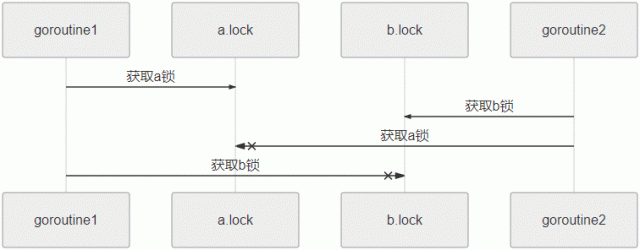package main
import (
"fmt"
"runtime"
"sync"
"time"
)
type value struct {
memAccess sync.Mutex
value int
}
func main() {
runtime.GOMAXPROCS(3)
var wg sync.WaitGroup
sum := func(v1, v2 *value) {
defer wg.Done()
v1.memAccess.Lock()
time.Sleep(2 * time.Second)
v2.memAccess.Lock()
fmt.Printf("sum = %d\n", v1.value+v2.value)
v2.memAccess.Unlock()
v1.memAccess.Unlock()
}
product := func(v1, v2 *value) {
defer wg.Done()
v2.memAccess.Lock()
time.Sleep(2 * time.Second)
v1.memAccess.Lock()
fmt.Printf("product = %d\n", v1.value*v2.value)
v1.memAccess.Unlock()
v2.memAccess.Unlock()
}
var v1, v2 value
v1.value = 1
v2.value = 1
wg.Add(2)
go sum(&v1, &v2)
go product(&v1, &v2)
wg.Wait()
}
运行上面的代码,可能会看到:fatal error: all goroutines are asleep - deadlock!
为什么呢?如果仔细观察,就可以在此代码中看到时机问题,以下是运行时的图形表示。

图 :一个因时间问题导致死锁的演示
package main
import (
"bytes"
"fmt"
"runtime"
"sync"
"sync/atomic"
"time"
)
func main() {
runtime.GOMAXPROCS(3)
cv := sync.NewCond(&sync.Mutex{})
go func() {
for range time.Tick(1 * time.Second) { // 通过tick控制两个人的步调
cv.Broadcast()
}
}()
takeStep := func() {
cv.L.Lock()
cv.Wait()
cv.L.Unlock()
}
tryDir := func(dirName string, dir *int32, out *bytes.Buffer) bool {
fmt.Fprintf(out, " %+v", dirName)
atomic.AddInt32(dir, 1)
takeStep() //走上一步
if atomic.LoadInt32(dir) == 1 { //走成功就返回
fmt.Fprint(out, ". Success!")
return true
}
takeStep() // 没走成功,再走回来
atomic.AddInt32(dir, -1)
return false
}
var left, right int32
tryLeft := func(out *bytes.Buffer) bool {
return tryDir("向左走", &left, out)
}
tryRight := func(out *bytes.Buffer) bool {
return tryDir("向右走", &right, out)
}
walk := func(walking *sync.WaitGroup, name string) {
var out bytes.Buffer
defer walking.Done()
defer func() { fmt.Println(out.String()) }()
fmt.Fprintf(&out, "%v is trying to scoot:", name)
for i := 0; i < 5; i++ {
if tryLeft(&out) || tryRight(&out) {
return
}
}
fmt.Fprintf(&out, "\n%v is tried!", name)
}
var trail sync.WaitGroup
trail.Add(2)
go walk(&trail, "男人") // 男人在路上走
go walk(&trail, "女人") // 女人在路上走
trail.Wait()
}
输出结果如下:
go run main.go
女人 is trying to scoot: 向左走 向右走 向左走 向右走 向左走 向右走 向左走 向右走 向左走 向右走
女人 is tried!
男人 is trying to scoot: 向左走 向右走 向左走 向右走 向左走 向右走 向左走 向右走 向左走 向右走
男人 is tried!
package main
import (
"fmt"
"runtime"
"sync"
"time"
)
func main() {
runtime.GOMAXPROCS(3)
var wg sync.WaitGroup
const runtime = 1 * time.Second
var sharedLock sync.Mutex
greedyWorker := func() {
defer wg.Done()
var count int
for begin := time.Now(); time.Since(begin) <= runtime; {
sharedLock.Lock()
time.Sleep(3 * time.Nanosecond)
sharedLock.Unlock()
count++
}
fmt.Printf("Greedy worker was able to execute %v work loops\n", count)
}
politeWorker := func() {
defer wg.Done()
var count int
for begin := time.Now(); time.Since(begin) <= runtime; {
sharedLock.Lock()
time.Sleep(1 * time.Nanosecond)
sharedLock.Unlock()
sharedLock.Lock()
time.Sleep(1 * time.Nanosecond)
sharedLock.Unlock()
sharedLock.Lock()
time.Sleep(1 * time.Nanosecond)
sharedLock.Unlock()
count++
}
fmt.Printf("Polite worker was able to execute %v work loops\n", count)
}
wg.Add(2)
go greedyWorker()
go politeWorker()
wg.Wait()
}
输出如下:
Greedy worker was able to execute 276 work loops
Polite worker was able to execute 92 work loops
本文链接:http://task.lmcjl.com/news/14388.html